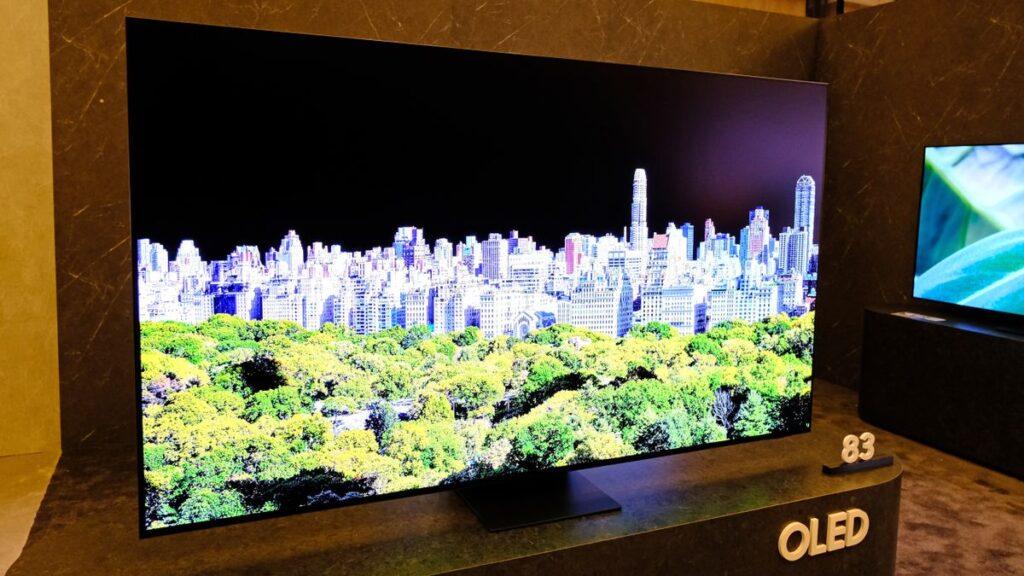At CES 2025, Samsung unveiled its next flagship OLED TV, the Samsung S95F. While the slickest feature may be the very impressive OLED Glare Free 2.0 reflection-reducing coating, there were two other elements that Samsung touted: a new 83-inch size option (along with the 55-inch, 65-inch, and 77-inch sizes already available ); and the promise of dazzling brightness of up to 4,000 nits.
Given that in our testing of the best OLED TVs we’ve yet to measure one that makes it above 2,000 nits of brightness, I had to know more about this, and I spoke to Samsung about exactly what I could expect.
One reason I wasn’t sure about that was that the new 83-inch model doesn’t use the same Samsung QD-OLED screen technology as the other sizes; instead, it uses a W-OLED panel, made by LG Display. Samsung didn’t confirm this, but given the brightness requirements, it must be the latest generation ‘four stack’ OLED panel from LG.
Samsung says that each size of the S95F will have the same level of performance, including the promise of reaching 4,000 nits of peak HDR brightness. However, Samsung specified that this claim is certainly extreme – something the panel is skilled to do in real life, but it hardly happens much. The company told me that this can be hit in a 3% HDR window for a few seconds, and it will probably require a certain picture mode to achieve.
The more useful real-world measurement, and no less impressive for that matter, is that Samsung says all models will be able to reach 2,000 nits of peak HDR brightness in a 10% window, and this can maintained.
That’s still higher than we’ve measured from any OLED TV to date, and really puts OLED TVs in line with the best mini-LED TVs for maximum brightness (at least the regular ones – not like Hisense 110UX and its claim of up to 10,000 nits).
Full-screen brightness for this year’s OLED TVs also appears to have improved – with the S95F jumping to just under 400 nits, from around 320 nits for the S95D. The LG G5 flagship OLED promises a 40% jump in full-screen brightness, which would put it at around 350 nits.
However, these numbers are still much lower than high-end mini LED TVs, which can hit 500-600 nits of full-screen brightness, which is why we rate them as the best TVs for sports, where brightness across the entire screen is important, to make everything bright and vivid at once and to beat reflections (although that’s what Samsung’s Glare Free coating is supposed to help with).
Time to ditch the old worries?
In the past, when Samsung has mixed QD-OLED and W-OLED panels in different screen sizes, it has given us a big headache. Take the Samsung S90C OLED TV, which we’ve rated as the best TV overall for a long time … at least in most sizes. Like the Samsung S95F, that set came in 55-inch, 65-inch, 77-inch and 83-inch sizes – and the three smaller sizes were made with a Samsung QD-OLED display, while the 83-inch size was an LG W-OLED panel.
The problem was that at the time, the mid-range QD-OLED displays were much brighter than LG’s mid-range W-OLED displays, so we basically just had to say that we didn’t recommend the 83-inch size because we thought the 83-inch LG C3 was better value as it used the same panel .
So in the past, whenever I heard that Samsung was using different panel types in different sizes for one of its OLEDs, I got an instant migraine. We knew the performance of these panels and we knew they could not be equal.
But Samsung says that’s not the case in the S95F. I was told for sure that the promise of 4,000 nits extreme brightness and 2,000 nits continuous brightness will apply to the 83-inch W-OLED size as well as the QD-OLED size.
Obviously, we’re aiming to measure and confirm this ourselves – I can only hope we get our hands on it sooner rather than later, because the S95F is definitely one of the most exciting TVs of 2025.



